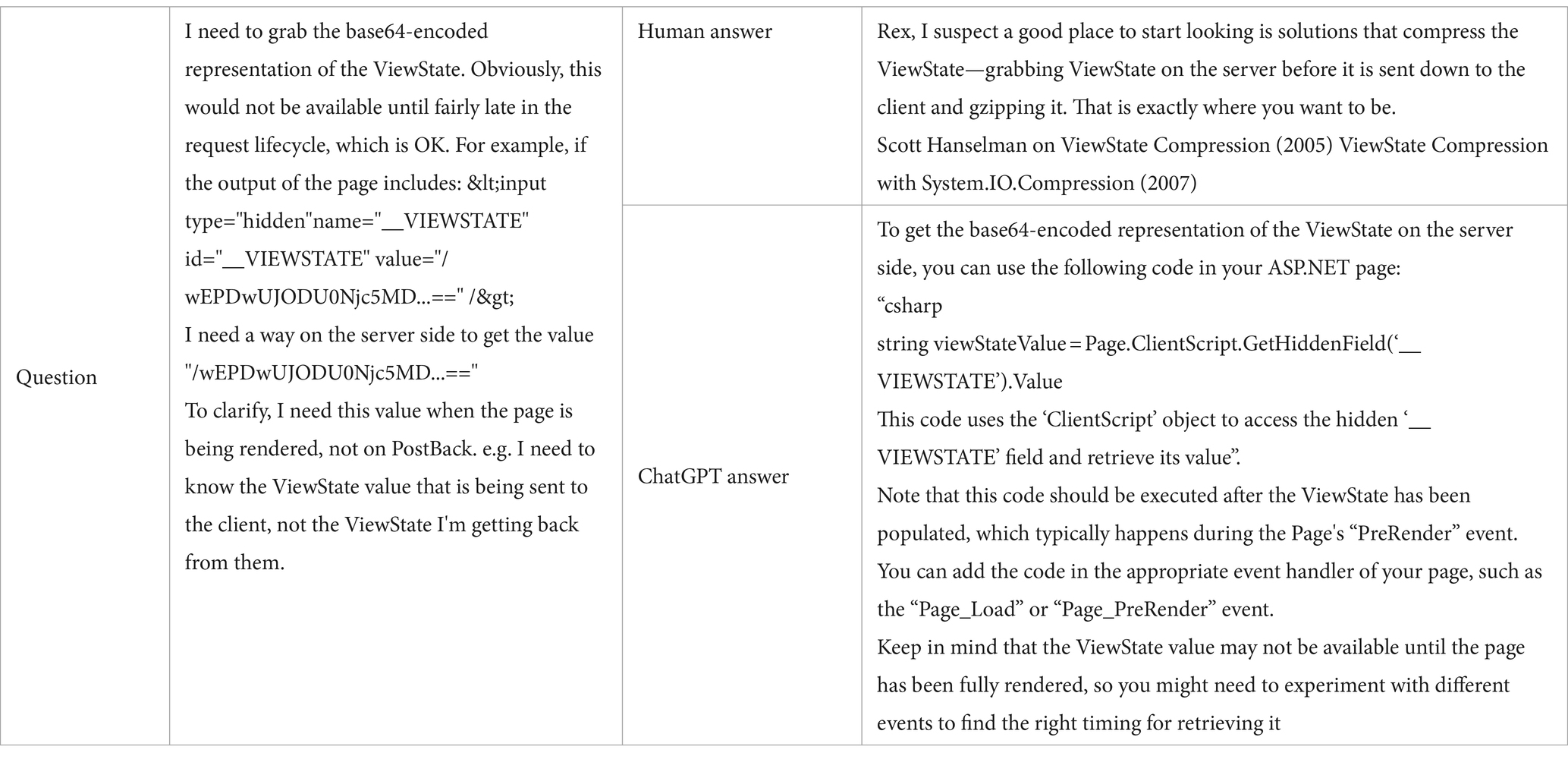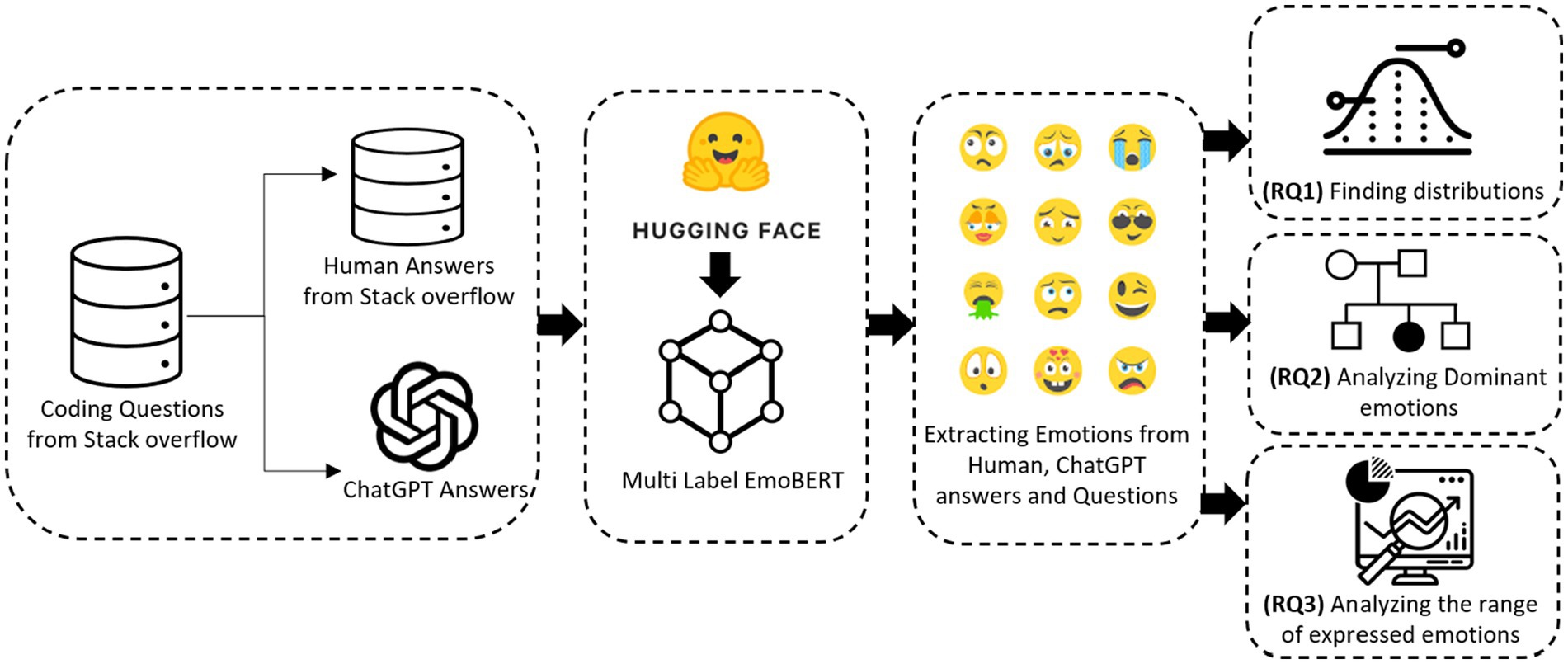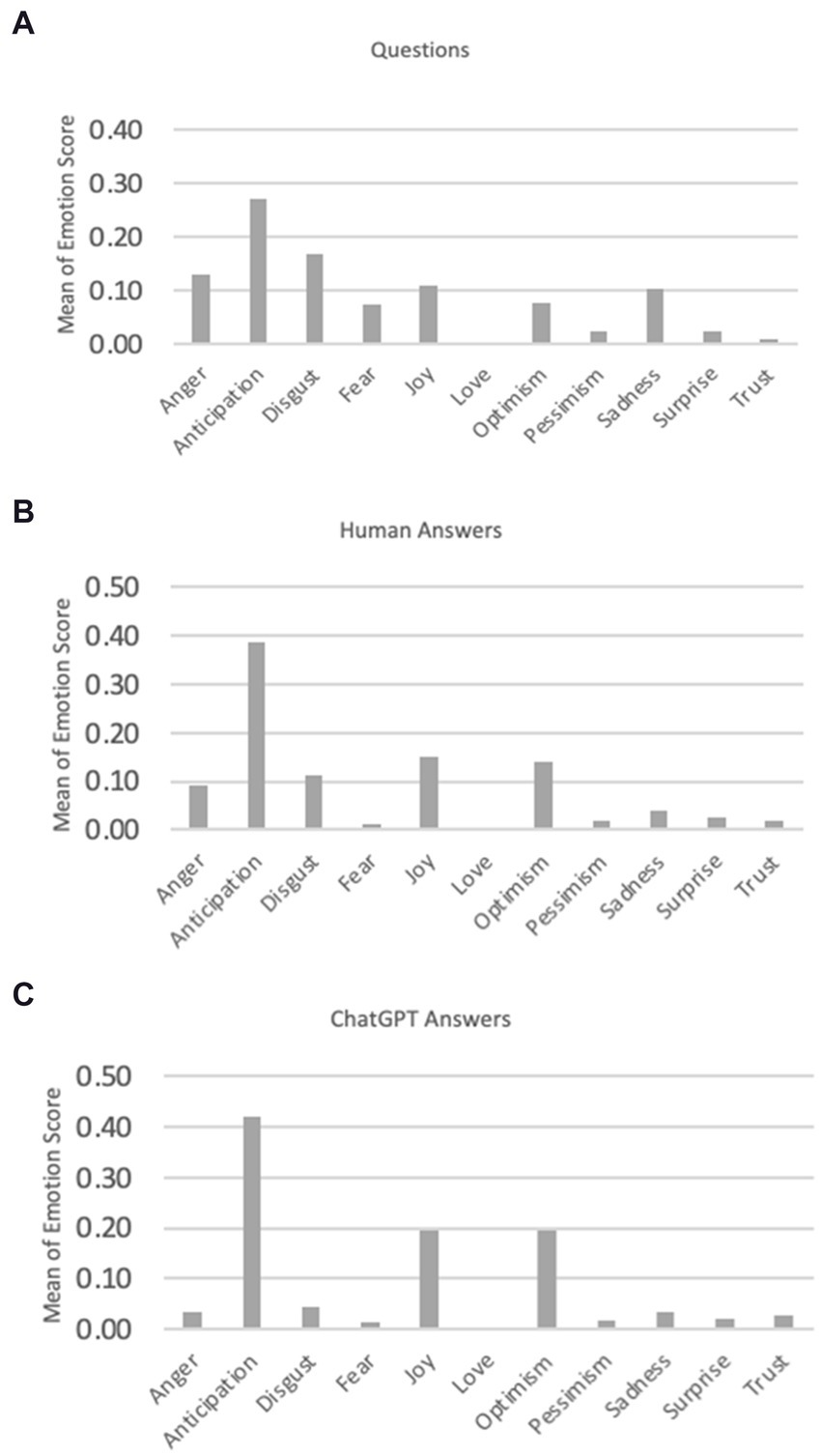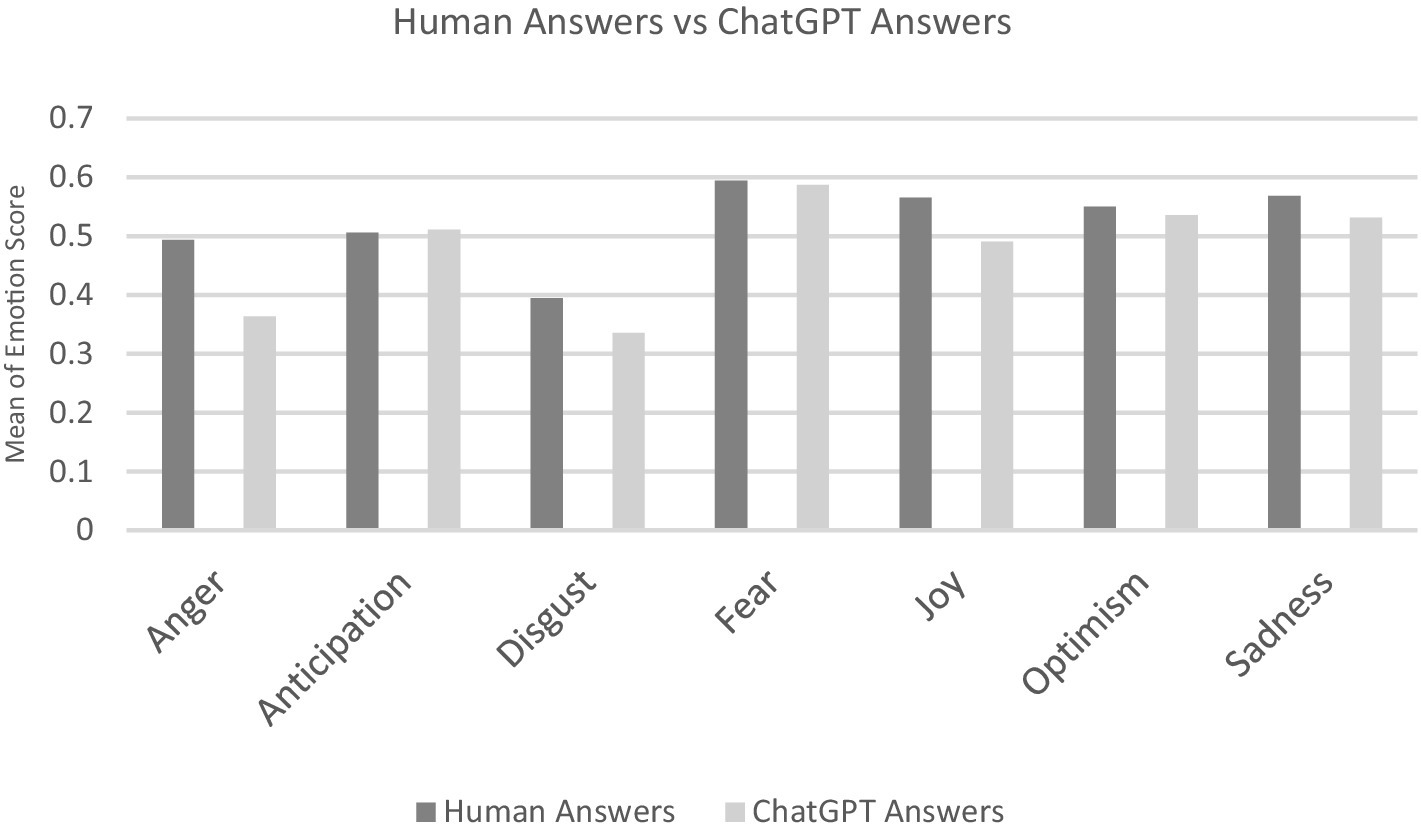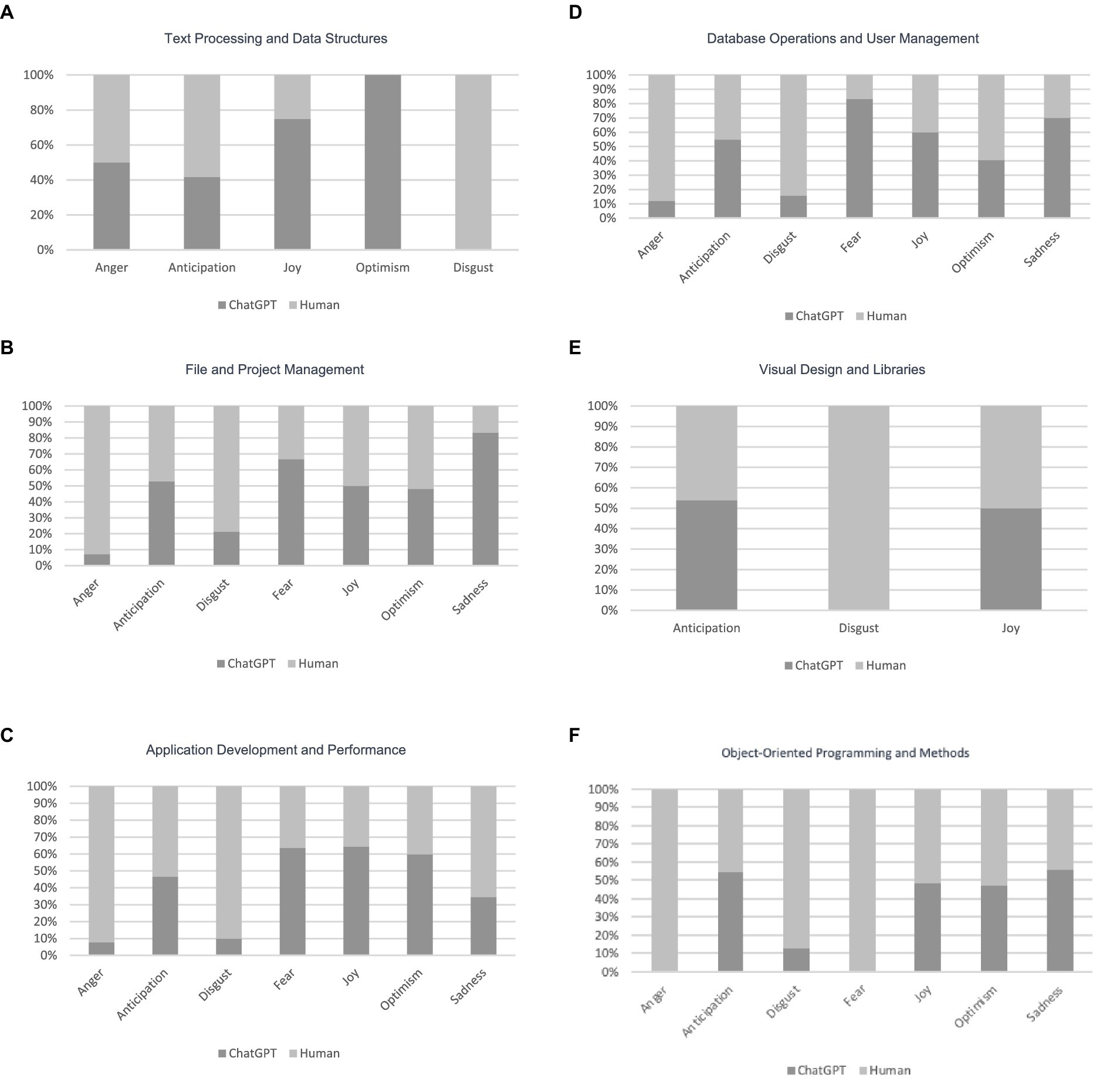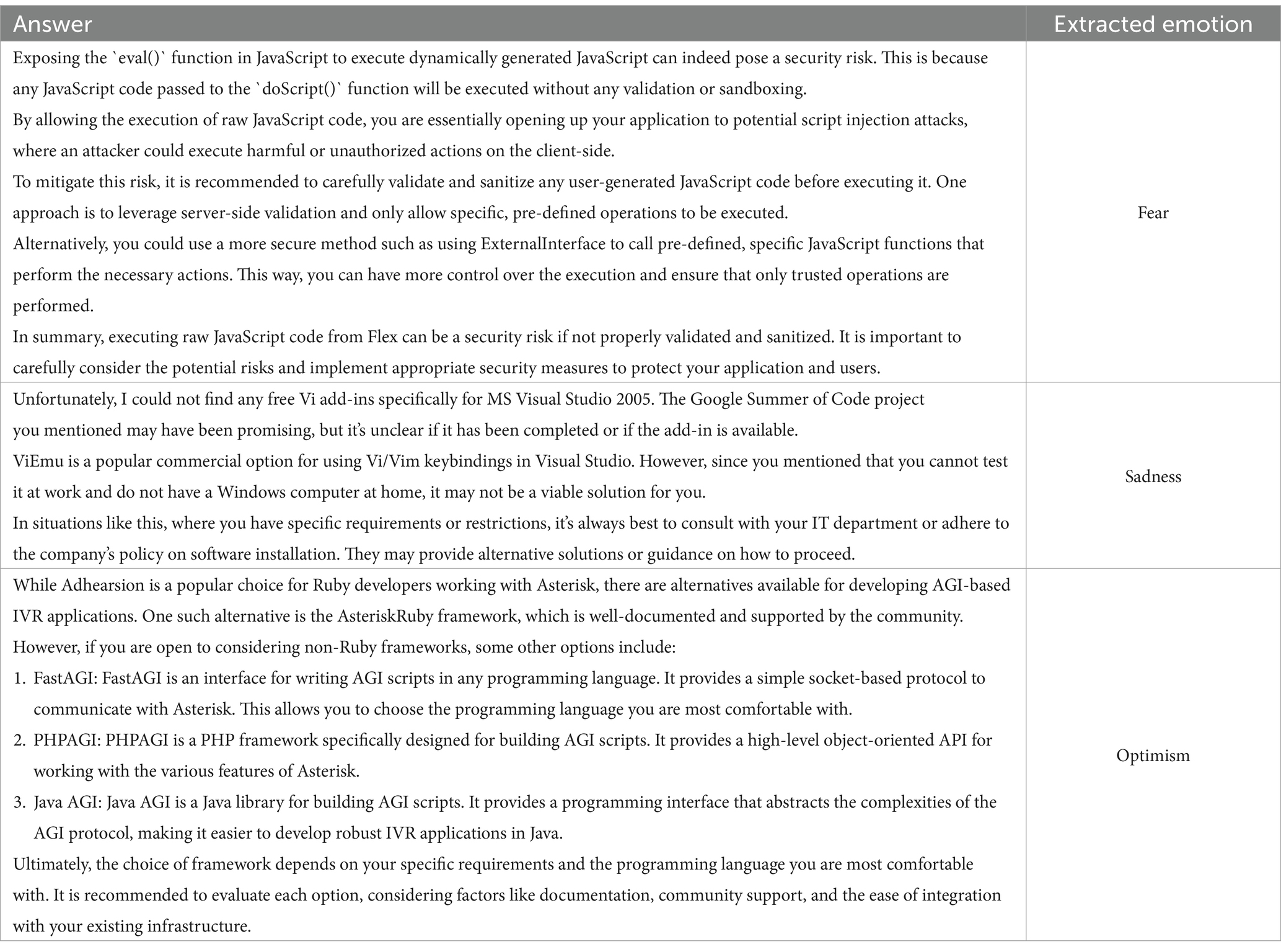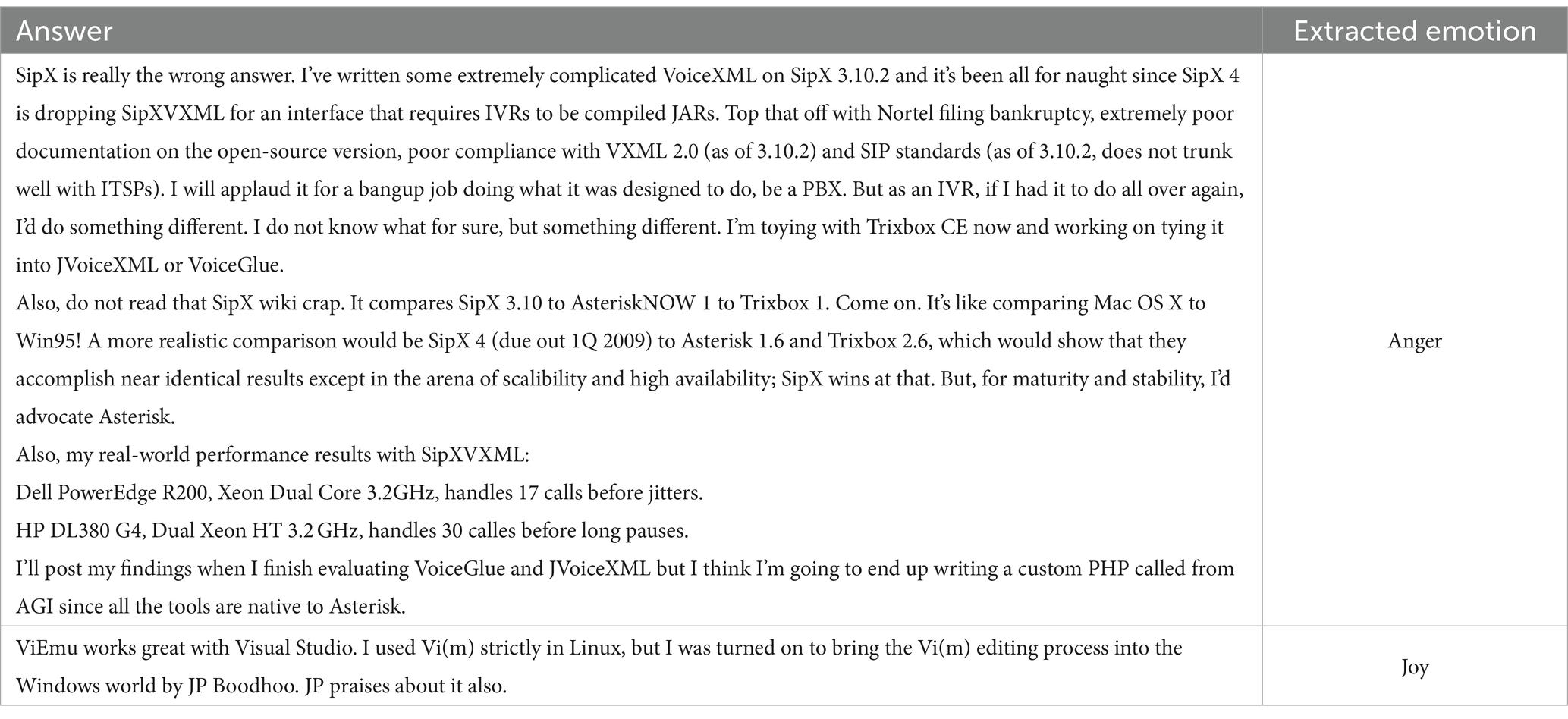- Department of Computer Science, University of Saskatchewan, Saskatoon, SK, Canada
Introduction: Recent advances in generative Artificial Intelligence (AI) and Natural Language Processing (NLP) have led to the development of Large Language Models (LLMs) and AI-powered chatbots like ChatGPT, which have numerous practical applications. Notably, these models assist programmers with coding queries, debugging, solution suggestions, and providing guidance on software development tasks. Despite known issues with the accuracy of ChatGPT’s responses, its comprehensive and articulate language continues to attract frequent use. This indicates potential for ChatGPT to support educators and serve as a virtual tutor for students.
Methods: To explore this potential, we conducted a comprehensive analysis comparing the emotional content in responses from ChatGPT and human answers to 2000 questions sourced from Stack Overflow (SO). The emotional aspects of the answers were examined to understand how the emotional tone of AI responses compares to that of human responses.
Results: Our analysis revealed that ChatGPT’s answers are generally more positive compared to human responses. In contrast, human answers often exhibit emotions such as anger and disgust. Significant differences were observed in emotional expressions between ChatGPT and human responses, particularly in the emotions of anger, disgust, and joy. Human responses displayed a broader emotional spectrum compared to ChatGPT, suggesting greater emotional variability among humans.
Discussion: The findings highlight a distinct emotional divergence between ChatGPT and human responses, with ChatGPT exhibiting a more uniformly positive tone and humans displaying a wider range of emotions. This variance underscores the need for further research into the role of emotional content in AI and human interactions, particularly in educational contexts where emotional nuances can impact learning and communication.
1 Introduction
With the advancement of technology, especially in artificial intelligence (AI), we are witnessing the emergence of novel tools. Over the past decade, text-based chatbots have gained widespread popularity across diverse application domains. This surge in adoption has been described as a ‘chatbot tsunami’ (Grudin and Jacques, 2019), enabling human interaction with machines through natural written language. In November of 2022, OpenAI introduced ChatGPT-3.5 (Open AI, 2023), a chatbot AI built on top of existing Large Language Models (LLMs) to facilitate interactive communication through a conversational interface. OpenAI achieved this interactive capability by employing reinforcement learning from human feedback, building upon prior work from InstructGPT (Ouyang et al., 2022). ChatGPT rapidly gained popularity and attained a milestone by amassing 100 million users by January 2023 (Saini, 2023), reaching 1.5 billion monthly visitors as of the time of writing this paper. ChatGPT can generate diverse text forms, encompassing scientific abstracts, domain-specific question answers, programming code, lifelike conversational exchanges, text summarization, language translation, and providing suggestions and recommendations. However, ChatGPT also carries potential risks, such as enabling copyright violations, plagiarism, over-dependence, and possibly reduced creativity. Also, studies indicate that people are concerned about cybersecurity threats posed by malicious entities using ChatGPT to create harmful code, hack, gather information, and trick people into revealing private or sensitive information (Okey et al., 2023; Khoury et al., 2023; Poremba, 2023; Malwarebytes, 2023). The risk of AI-generated content being passed off as human-written may lead to potential harm, such as the spread of fake content on social media. AI-generated content is riskier than human-written posts because AI can produce vast amounts of tailored misinformation quickly, making it hard to detect and flag. Its ability to personalize messages increases their persuasiveness, and the autonomous, adaptable nature of AI allows it to continuously evolve and evade detection. It could also cause significant problems in various areas, such as information security and digital forensics. In addition to its ability to provide specific answers to user questions, ChatGPT can be utilized for completing written assignments and examinations on behalf of students, raising concerns about AI-assisted cheating (Susnjak and McIntosh, 2024). In response, some schools have implemented bans on access to ChatGPT on campus (Dibble, 2023). The implications of ChatGPT in the field of education were explored in a review and the findings revealed that educators expressed concerns about the use of ChatGPT in education, fearing that students might outsource their work to ChatGPT due to its capability to rapidly generate acceptable texts (Mhlanga, 2023). Although the development of ChatGPT can be challenging, it may simplify the application of AI in teaching and learning, making it more accessible for instructors and helping students increase their knowledge in a proper way. Despite the drawbacks associated with misusing AI Chatbots like ChatGPT, there are numerous advantages in its application in education. These include personalized tutoring: ChatGPT facilitates personalized tutoring, leading to enhanced learning outcomes (Alshahrani, 2023). Automated essay grading: It streamlines the essay grading process, saving valuable time for teachers (Parker et al., 2023). ChatGPT aids in language translation, making educational materials more accessible to a broader audience (Zhao et al., 2024). Interactive learning: It promotes interactive learning, offering effective support for students (Murad et al., 2023). Adaptive learning: ChatGPT could potentially adapt teaching methods based on a student’s progress and performance, especially in the context of learning programming languages.
Given the significant influence of emotions on perception, the learning process (Tyng et al., 2017), and communication in humans, there is substantial evidence indicating that learning is intertwined with emotions (Hökkä et al., 2020; Bohn-Gettler and Kaakinen, 2022; Um et al., 2012). Consequently, if ChatGPT interacts with humans in a way that aligns with the positive aspects such as optimism and positive emotions, it could prove more beneficial in the field of education by effectively assuming the role of a teacher, as previous research has shown the impact of AI on learning (Wang et al., 2024; Kasneci et al., 2023). However, there is still a lack of research in education comparing the emotional content in human and AI responses, which warrants further investigation for a comprehensive understanding.
The current trend in chatbot development is toward empathetic and emotionally intelligent bots, capable of recognizing user feelings and generating fitting answers (Adamopoulou and Moussiades, 2020). However, to what extent can AI chatbots understand human emotions and respond with a human level of empathy, and to what extent can they mimic believable emotional responses to a situation? Despite notable advancements in chatbot development (Adam et al., 2021; Rapp et al., 2021; Adamopoulou and Moussiades, 2020), accurately capturing and expressing the right emotions within chatbot interactions remains a persistent challenge. ChatGPT has shifted researchers’ perspectives to some extent. For instance, one study (Elyoseph et al., 2023) showcased ChatGPT’s capacity to produce suitable Emotional Awareness (EA) responses, with the potential for significant improvement over time.
However, there is a gap in research when it comes to comparing the emotional aspects of human and ChatGPT responses in different areas. Our study focuses on understanding these differences in how questions related to programming language are answered. Learning programming is tough for many in education today, and ChatGPT can assist students and programmers with problem-solving. That is why we have chosen this field to look into the emotional differences in responses between humans and ChatGPT. The findings from this research may offer useful insights that could inform future developments of ChatGPT, enhancing its utility for education and learning.
To accomplish this goal, we address the following research questions:
Research Questions:
RQ1: What is the distribution of emotions in questions, human-generated answers and ChatGPT answers?
RQ2: What are the dominant emotions exhibited in ChatGPT answers, and what are the dominant emotions in human-generated answers?
RQ3: How does the range of expressed emotions differ between human generated and ChatGPT answers?
To answer our research questions, we conducted a comprehensive analysis, comparing emotional aspects in responses from both ChatGPT and humans to 2000 questions sourced from Stack Overflow (SO).
The subsequent sections of this paper are structured as follows: Section 2 delves into the literature review of our study, providing an overview of recent research related to ChatGPT. Section 3 outlines our methodology. The results are presented in Section 4, followed by the discussion in Section 5 and the conclusion in Section 6.
2 Literature review
Since November 2022, ChatGPT has attracted significant attention, resulting in numerous applications and extensive research (Kalla et al., 2023). This section aims to provide a clearer introduction to the applications of ChatGPT within the context of software engineering. Specifically, we explore its utility within the Stack Overflow dataset, focusing on studies that examine ChatGPT’s role and effectiveness in this domain.
Jalil et al. (2023), the researchers assess the performance of ChatGPT in addressing common queries from a used software testing curriculum. Their investigation shows that ChatGPT’s current capabilities effectively address 77.5% of the questions examined. Among these questions, it provides fully or partially accurate answers in 55.6% and correct or partially correct explanations in 53% of the cases. The findings of this research diverge from the outcomes of implementing ChatGPT in other fields, such as medicine (Kung et al., 2023) or law (Choi et al., 2021), where ChatGPT has demonstrated success in passing specific portions of their examinations. This discrepancy suggests that although ChatGPT exhibits capability, it also possesses limitations, including a lack of comprehensive knowledge and the tendency to make incorrect assumptions, contributing to potential response inaccuracies.
Surameery and Shakor (2023), researchers investigated the role of ChatGPT in solving programming bugs. They found that ChatGPT is superior to other tools in cost, speed, customization, ease of use, and scalability. However, when it comes to fitting into existing systems, traditional debugging tools are more effective due to their integration capabilities. Additionally, the accuracy of ChatGPT depends on the quality of its training data, while traditional debugging tools generally provide higher accuracy levels.
An empirical investigation (Nascimento et al., 2023) compared the performance of software engineers and AI systems, such as ChatGPT, across various evaluation metrics. ChatGPT-generated code was evaluated against code created by developers and submitted on Leetcode. The study revealed that automated systems like ChatGPT can, in certain instances, surpass the performance of novice software engineers in specific tasks. This superiority was particularly apparent in resolving easy and medium-level problems, where ChatGPT consistently outperformed novice contest programmers.
Kabir et al. (2023), a comprehensive analysis was conducted on ChatGPT’s answers to 517 questions sourced from Stack Overflow (SO). The assessment encompassed the correctness, consistency, comprehensiveness, and conciseness of these answers. The manual analysis indicated that 52% of the answers provided by ChatGPT contained inaccuracies, while 77% were found to be excessively verbose. Nevertheless, users preferred ChatGPT’s answers 39.34% of the time due to their thoroughness and articulate language style. The results of the linguistic analysis demonstrated the formal nature of ChatGPT’s answers, which rarely expressed negative sentiments. Although the user study showed that users had a higher preference and quality rating for SO, they occasionally erred by favoring incorrect ChatGPT answers due to the model’s well-articulated language style and seemingly plausible logic presented with positive assertions. These findings highlight the requirement for meticulous error correction within ChatGPT while also emphasizing the need to make users aware of the potential risks associated with answers that appear accurate.
Liu et al. (2023) conducted a study to examine the comparative efficacy of ChatGPT and SO in assisting programmers. Two groups of students with similar programming abilities were instructed to use the two platforms to solve three programming tasks: algorithmic challenges, library usage, and debugging. The findings reveal that, in terms of code quality, ChatGPT exhibits significantly better performance than SO when aiding in the completion of algorithmic and library-related tasks. However, Stack Overflow proves more beneficial for debugging tasks. Concerning task completion speed, the ChatGPT group demonstrates notably faster results than the SO group, specifically in algorithmic challenges, while displaying similar performance in the other two tasks.
Delile et al. (2023) explore the privacy issues encountered by developers. They compare the responses accepted on SO with those generated by ChatGPT for these queries to evaluate if ChatGPT could be a helpful alternative. The results reveal that most privacy-related questions center on choice/consent, aggregation, and identification. Additionally, ChatGPT provides roughly 56% of responses that match the accuracy level of SO.
Following Stack Overflow’s decision to ban ChatGPT, Borwankar et al. (2023) examined how the users of SO responded to this change. They studied the quality of content using natural language processing (NLP) techniques and voting patterns across SO and the AskProgramming subreddit on Reddit. The results indicate that SO users adjusted their answer style after the limitation, leading to more positive, longer responses than AskProgramming subreddit users. This study shows that there has been an improvement in content quality post-limitation, reflected in increased upvotes for answers.
The research discussed in this section sheds light on various aspects of ChatGPT’s capabilities and limitations in software engineering. A prevailing consensus suggests that the ability to differentiate between ChatGPT and human-generated text is crucial. As mentioned, emotion is a distinguishing factor for identifying the human and ChatGPT (Pamungkas, 2019). However, it is noteworthy that relatively few studies have investigated emotion in communication with ChatGPT. Elyoseph et al. (2023) focused on assessing the emotional awareness (EA) capabilities of ChatGPT. Using the Levels of Emotional Awareness Scale (LEAS), researchers conducted two examinations involving 20 scenarios to evaluate ChatGPT’s EA performance, comparing it to norms established by a previous study. ChatGPT’s emotional awareness (EA) scores were compared to those in a previous study (Nandrino et al., 2013). To check how accurate ChatGPT’s answers were, two professional psychologists independently rated each answer based on how well it fits the situation. They used a scale from 0, meaning “the feelings described do not match the scenario at all,” to 10, meaning “the emotions described fit the scenario perfectly.” The results illustrated that ChatGPT can produce suitable emotional awareness (EA) answers, potentially enhancing performance over time.
To the best of our knowledge, no existing research compares emotions in answers generated by ChatGPT with those created by humans in the software engineering domain. Additionally, there has yet to be a study focused on using emotion as a fingerprint to differentiate between human and ChatGPT-generated answers. This paper addresses these gaps and delves into this unexplored research area.
3 Methodology
This study uses a comparative analysis approach to assess the answers generated by ChatGPT in contrast to those provided by humans on Stack Overflow.
3.1 Data
We chose the subject matter, Software Engineering, because it is less inclined toward emotional interactions, as it is primarily about resolving programming problems. This makes it a more ‘neutral’ domain for analysis. For instance, datasets containing reviews of products, hotels, or restaurants are likely to feature numerous strongly opinionated positive and negative reviews. This could skew the comparison, placing a heavier emphasis on human emotions.
As a source of data, we chose Stack Overflow because it is a popular free question-and-answer community, extensively used for many years by programmers and software engineers (Spolsky and Atwood, 2008), and the data is readily accessible and abundant. We used the open dataset1 provided in Kabir et al., 2023, comprising answers from ChatGPT and human experts to a randomly selected set of 2000 Stack Overflow questions. As an example, one of the data points is presented in Table 1.
3.2 Model
To extract emotions from the questions, ChatGPT answers, and human answers, we utilized an emotion-multilabel model from Hugging Face. This model is a fine-tuned version of cardiffnlp/twitter-roberta-base-2022-154 m (Mohammad et al., 2018) and is based on EmoBERT, a novel emotion-based variant of the BERT (Devlin et al., 2018) transformer model. Multi-label EmoBERT comprises three main components. The first component involves two encoders: one for all tokens (Word Encoder) and another designed explicitly for emotion-word hashtag tokens (Hashtag Encoder). The second component is a compositional layer that represents sentiment semantic composition. The final component is a label correlation layer that learns the correlation between co-existing emotions.
The emotions were selected for this model based on the basic emotion model (Ekman, 1992; Plutchik, 1980; Parrott, 2001; Frijda, 2017) and the valence–arousal–dominance (VAD) model (Russell, 1980). Finally, researchers considered an emotion classification task encompassing 11 emotions commonly expressed in tweets: anger, anticipation, disgust, fear, joy, love, optimism, pessimism, sadness, surprise, and trust for this model.
Its performance demonstrated close approximation to published results in extracting emotions from the Stack Overflow dataset, achieving a Micro-F1 score of 83.36 (Li and Xiao, 2023). The schematic diagram of our study is shown in Figure 1.
4 Results
When the Multi-label EmoBERT model is applied to the dataset, it produces a vector of emotions as an output (Table 2). This vector comprehensively represents the emotional content embedded within the questions and the sets of humans and ChatGPT answers. In the initial phase, we used the Chi-squared test to examine the relationship between the emotion in the question and the emotional response from both humans and ChatGPT. As depicted in Table 3, our findings indicate a notable correlation between the emotions conveyed in questions and the emotional responses from both human participants and ChatGPT. It should be mentioned that we opted to use the Chi-squared test instead of the Pearson correlation for the following reasons. The Chi-squared test is particularly suitable for categorical data, in contrast, the Pearson correlation coefficient is designed to measure the linear relationship between two continuous variables. Our data consisted of categorical variables in this step, making the Chi-squared test the appropriate choice. Also, the Chi-squared test is used to determine whether there is a significant association between two categorical variables. Our objective was to assess the independence or association between these variables. The Pearson correlation assumes a linear relationship between variables and can provide misleading results when applied to non-linear or non-continuous data. The Chi-squared test does not require any assumptions about the nature of the relationship between the variables other than their categorical nature, making it more flexible and appropriate for our analysis. In the next step, we calculate the average value of emotions in SO questions, human answers, and ChatGPT answers. As Figure 2 shows, questions frequently exhibit emotions such as anticipation, anger, and disgust. There is a notable similarity in emotional patterns between humans and ChatGPT.

Table 3. Relationship between emotions in Stack Overflow questions and answers from human and ChatGPT.
Upon a detailed comparison of human and ChatGPT answers, shown in Figure 2, it becomes evident that ChatGPT answers tend to be more optimistic and joyful, while human answers often contain more expressions of anger and disgust.
In the next step, our focus shifts to identifying the predominant emotion in both the questions and their corresponding answers. We determine the maximum emotion intensity for each answer rather than considering a range of different emotions. As shown in Table 2, a spectrum of emotions is present, but Anticipation emerges as the dominant emotion for both the question and the answers from humans and ChatGPT. Now we focus our attention on the dominant emotions, excluding those detected marginally, e.g., Love, Pessimism, and Trust (see Figure 3). Notably, when we focus solely on the dominant emotion for each question/answer and calculate the mean emotion value, it differs from the previous calculation.
To understand the data distribution, we examined how the data is dispersed using a box plot (Figure 4). The results show that for some emotions, such as Anger, Disgust, and Joy, there are considerable differences between ChatGPT and human responses. Notably, human emotions exhibited a wide dispersion. Conversely, for emotions like Anticipation, Optimism, and Sadness, the distributions appeared consistent between human and ChatGPT-generated answers.
We performed a t-test to compare the data represented in the boxplots shown in Figure 4. For the “Anger” variable, the results indicate that the t-statistic is 6.27 and the p-value is 1.28e-6. These results suggest a highly significant difference between the groups being compared. The large t-statistic indicates a substantial difference in the means of the two groups, while the extremely small p-value indicates that this difference is statistically significant, far below the conventional significance level of 0.05. This provides strong evidence that the observed differences in “Anger” levels between the groups are not due to random chance.
For “Disgust,” the results show that the t-statistic is 4.36 and the p-value is 1.89e-5. Since the p-value (0.0000189) is far below the common significance level of 0.05, we can reject the null hypothesis. This means there is strong evidence to suggest a significant difference between the means of the two groups.
For “Joy,” the p-value is 4.41e-7 (0.00000044), which is much smaller than the conventional significance level of 0.05. This indicates that there is a statistically significant difference between the two groups.
In the next step, we applied topic modeling (Alghamdi and Alfalqi, 2015) to uncover the relationships between topics and emotions (Table 4). Specifically, we utilized Latent Dirichlet Allocation (LDA; Blei et al., 2003), a probabilistic generative model widely employed in natural language processing (NLP) and machine learning. LDA is a technique adept at identifying underlying topics within a set of documents. In our analysis, we employed the LDA model on the questions, human answers, and ChatGPT-generated answers to extract topics.
When examining Figure 5, it becomes evident that each topic is associated with a predominant emotion. For instance, in the case of Text Processing and Data Structures topic, Disgust holds a prominent proportion compared to other emotions in the human answers.
We conducted a statistical analysis, and the results are shown in Table 5. The results confirm that in each topic, the Chi-square test results show significant differences in the proportions of emotions between ChatGPT and human responses. The very low p-values across all topics confirm that the observed differences are statistically significant, indicating real and substantial differences in how emotions are represented by ChatGPT versus humans in each topic (Tables 6, 7).

Table 5. Chi-square test results for emotional proportions in ChatGPT vs. human responses across topics.
5 Discussion
We conducted a comprehensive analysis comparing emotional aspects in answers from ChatGPT and humans to 2000 questions sourced from Stack Overflow. Our findings indicate notable differences in emotional expression between humans and ChatGPT across various topics. Humans tend to have more negative responses with higher variance compared to ChatGPT. ChatGPT’s responses tend to lean toward optimism, whereas humans are more inclined toward expressing anger and disgust. This difference may be one of reasons people prefer ChatGPT’s answers 40% of the time due to their thoroughness and articulate language style (Liu et al., 2023).
When humans express an emotion, the variance is larger than in ChatGPT. It appears that ChatGPT provides responses based on patterns in training data and aims to be helpful. Human responders on Stack Overflow are real individuals with their own feelings, thoughts, and experiences.
Upon investigating the results comparing emotions in different topics, it is evident that humans tend to exhibit consistent emotional responses, encompassing feelings of Disgust or Anger. In contrast, ChatGPT demonstrates a discrepancy in emotional expression across various topics, expressing a range of emotions including Optimism, Sadness, Joy, Fear, and Anticipation. This suggests that human responses may be more authentic and natural, stemming from the inherent frustration of the searching process.
In exploring RQ1, the initial analysis shows that ChatGPT’s answers tend to be more optimistic and joyful, while human answers often contain more expressions of anger and disgust.
In addressing RQ2, when we focus on the predominant emotion and determine the maximum emotion intensity for each answer, Anticipation emerges as the dominant emotion for both the questions and the answers from humans and ChatGPT. Additionally, the results show considerable differences between ChatGPT and human responses for some emotions, such as Anger, Disgust, and Joy. Human emotions exhibit higher variance compared to ChatGPT.
Regarding RQ3, investigating emotions across different subjects reveals substantial differences in how emotions are represented by ChatGPT versus humans in each topic. Specifically, our analysis highlights that humans tend to exhibit a narrower emotional range within each topic, predominantly showing negative emotions like Disgust and Anger. This consistency in human emotional expression across topics could be attributed to the personal and situational frustrations users encounter when seeking help on technical issues.
Understanding these differences in emotional expression is crucial for improving AI systems like ChatGPT and holds importance from three perspectives.
Detection of AI-generated Text: The emotional differences can serve as unique fingerprints, enabling the detection of text generated by ChatGPT when compared to human-generated content.
Application in Supportive Roles: Generative AI and LLM-based chatbots may be particularly suited for roles where being a patient, optimistic, and joyful partner in dialog is beneficial, such as in education, online help, and customer service applications.
Enhancing AI Emotional Diversity: For developing more believable and empathetic AI chatbots, it is important to enhance their emotional diversity and variance. This can lead to more realistic emotional responses, making AI interactions more engaging and relatable. Future research could explore personalized and emotionally adaptive AI chatbots that reflect and respond to the user’s emotional tone. Such chatbots could be invaluable in areas like mental health counseling, child, and elderly care.
6 Conclusion
In this research, we conducted a comprehensive analysis comparing the emotional aspects of answers from ChatGPT and humans to 2,000 questions sourced from Stack Overflow. Our findings indicate notable differences in emotional expression between humans and ChatGPT across various topics. Humans tend to have more negative responses with higher variance compared to ChatGPT. ChatGPT’s responses tend to lean toward optimism, whereas humans are more inclined toward expressing anger and disgust.
Theses analysis highlights distinct emotional patterns across different topics. These insights underscore the need for improving AI systems to enhance their believability and user engagement, particularly in roles requiring supportive and patient interaction.
Data availability statement
The original contributions presented in the study are included in the article/supplementary material, further inquiries can be directed to the corresponding author.
Author contributions
SF: Writing – original draft, Writing – review & editing. JV: Writing – review & editing. CR: Writing – review & editing.
Funding
The author(s) declare that financial support was received for the research, authorship, and/or publication of this article. This work was supported by the Natural Sciences and Engineering Research Council (NSERC) Discovery Grant Program, grant RGPIN-2021-03521, awarded to Dr. Julita Vassileva; the Living Skies Postdoctoral Fellowship, awarded to Dr. Fatahi; and the NSERC CREATE in Software Analytics program, with fund number 121277, awarded to Dr. Chanchal Roy.
Acknowledgments
We would like to acknowledge the assistance of ChatGPT, version 3.5, for its support in checking the English grammar and enhancing the clarity of this paper. Its valuable contribution helped ensure the precision and quality of the written content.
Conflict of interest
The authors declare that the research was conducted in the absence of any commercial or financial relationships that could be construed as a potential conflict of interest.
Publisher’s note
All claims expressed in this article are solely those of the authors and do not necessarily represent those of their affiliated organizations, or those of the publisher, the editors and the reviewers. Any product that may be evaluated in this article, or claim that may be made by its manufacturer, is not guaranteed or endorsed by the publisher.
Footnotes
References
Adam, M., Wessel, M., and Benlian, A. (2021). AI-based chatbots in customer service and their effects on user compliance. Electron. Mark. 31, 427–445. doi: 10.1007/s12525-020-00414-7
Adamopoulou, E., and Moussiades, L., (2020). “An overview of chatbot technology.” In IFIP international conference on artificial intelligence applications and innovations (pp. 373–383). Springer, Cham.
Alghamdi, R., and Alfalqi, K. (2015). A survey of topic modeling in text mining. Int. J. Adv. Comput. Sci. Appl.(IJACSA) 6, 147–153. doi: 10.14569/IJACSA.2015.060121
Alshahrani, A. (2023). The impact of ChatGPT on blended learning: current trends and future research directions. Int J Data and Network Sci 7, 2029–2040. doi: 10.5267/j.ijdns.2023.6.010
Blei, D. M., Ng, A. Y., and Jordan, M. I. (2003). Latent dirichlet allocation. J. Mach. Learn. Res. 3, 993–1022.
Bohn-Gettler, C. M., and Kaakinen, J. K. (2022). Introduction to the special issue on emotions in reading, learning, and communication. Discourse Process. 59, 1–12.
Borwankar, S., Khern-am-nuai, W., and Kannan, K. N., (2023). Unraveling the impact: An empirical investigation of ChatGPT’s exclusion from stack overflow.
Choi, J. H., Hickman, K. E., Monahan, A. B., and Schwarcz, D. (2021). ChatGPT goes to law school. J. Leg. Educ. 71:387.
Delile, Z., Radel, S., Godinez, J., Engstrom, G., Brucker, T., Young, K., et al. (2023). “Evaluating privacy questions from stack overflow: can ChatGPT compete?.” In 2023 IEEE 31st international requirements engineering conference workshops (REW) (pp. 239–244). IEEE.
Devlin, J., Chang, M. W., Lee, K., and Toutanova, K. (2018). Bert: pre-training of deep bidirectional transformers for language understanding. arXiv preprint arXiv 1810:04805.
Dibble, M. (2023). Schools ban ChatGPT amid fears of artificial intelligence-assisted cheating. Washington, DC: VOA News.
Elyoseph, Z., Hadar-Shoval, D., Asraf, K., and Lvovsky, M. (2023). ChatGPT outperforms humans in emotional awareness evaluations. Front. Psychol. 14:1199058.
Grudin, J., and Jacques, R., (2019). “Chatbots, humbots, and the quest for artificial general intelligence.” In Proceedings of the 2019 CHI conference on human factors in computing systems (pp. 1–11).
Hökkä, P., Vähäsantanen, K., and Paloniemi, S. (2020). Emotions in learning at work: a literature review. Vocat. Learn. 13, 1–25. doi: 10.1007/s12186-019-09226-z
Jalil, S., Rafi, S., LaToza, T. D., Moran, K., and Lam, W. (2023). “Chatgpt and software testing education: promises & perils.” In 2023 IEEE international conference on software testing, verification and validation workshops (ICSTW) (pp. 4130–4137). IEEE.
Kabir, S., Udo-Imeh, D. N., Kou, B., and Zhang, T. (2023). Who answers it better? An in-depth analysis of chatgpt and stack overflow answers to software engineering questions. arXiv preprint arXiv 2308:02312.
Kalla, D., Smith, N., Samaah, F., and Kuraku, S. (2023). Study and analysis of chat GPT and its impact on different fields of study. Int J Innovative Sci Res Technol 8, 1–12.
Kasneci, E., Seßler, K., Küchemann, S., Bannert, M., Dementieva, D., Fischer, F., et al. (2023). ChatGPT for good? On opportunities and challenges of large language models for education. Learn. Individ. Differ. 103:102274.
Khoury, R., Avila, A. R., Brunelle, J., and Camara, B. M., (2023). “How secure is code generated by chatgpt?.” In 2023 IEEE international conference on systems, man, and cybernetics (SMC) (pp. 2445–2451). IEEE.
Kung, T. H., Cheatham, M., Medenilla, A., Sillos, C., De Leon, L., Elepaño, C., et al. (2023). Performance of ChatGPT on USMLE: potential for AI-assisted medical education using large language models. PLoS Digital Health 2:e0000198. doi: 10.1371/journal.pdig.0000198
Li, J., and Xiao, L., (2023). “Multi-emotion recognition using multi-EmoBERT and emotion analysis in fake news.” In Proceedings of the 15th ACM web science conference 2023 (pp. 128–135).
Liu, J., Tang, X., Li, L., Chen, P., and Liu, Y. (2023). Which is a better programming assistant? A comparative study between chatgpt and stack overflow. arXiv preprint arXiv 2308:13851.
Mhlanga, D. (2023). “Open AI in education, the responsible and ethical use of ChatGPT towards lifelong learning” in FinTech and artificial intelligence for sustainable development: The role of smart technologies in achieving development goals (Springer Nature Switzerland: Cham), 387–409.
Mohammad, S., Bravo-Marquez, F., Salameh, M., and Kiritchenko, S. (2018). “Semeval-2018 task 1: affect in tweets.” In Proceedings of the 12th international workshop on semantic evaluation (pp. 1–17).
Murad, I. A., Surameery, N. M. S., and Shakor, M. Y. (2023). Adopting ChatGPT to enhance educational experiences. Int J Info Technol Comp Eng 3, 20–25. doi: 10.55529/ijitc.35.20.25
Nandrino, J. L., Baracca, M., Antoine, P., Paget, V., Bydlowski, S., and Carton, S. (2013). Level of emotional awareness in the general French population: effects of gender, age, and education level. Int. J. Psychol. 48, 1072–1079. doi: 10.1080/00207594.2012.753149
Nascimento, N., Alencar, P., and Cowan, D. (2023). Comparing software developers with chatgpt: an empirical investigation. arXiv preprint arXiv 2305:11837.
Okey, O. D., Udo, E. U., Rosa, R. L., Rodríguez, D. Z., and Kleinschmidt, J. H. (2023). Investigating ChatGPT and cybersecurity: a perspective on topic modeling and sentiment analysis. Comput. Secur. 135:103476. doi: 10.1016/j.cose.2023.103476
Open AI. (2023). “ChatGPT.” Available at: https://openai.com/blog/chatgpt
Ouyang, L., Wu, J., Jiang, X., Almeida, D., Wainwright, C., Mishkin, P., et al. (2022). Training language models to follow instructions with human feedback. Adv. Neural Inf. Proces. Syst. 35, 27730–27744.
Parker, J. L., Becker, K., and Carroca, C. (2023). ChatGPT for automated writing evaluation in scholarly writing instruction. J. Nurs. Educ. 62, 721–727. doi: 10.3928/01484834-20231006-02
Parrott, W. G. (2001). Emotions in social psychology: Essential readings. New York, NY, US: psychology press.
Plutchik, R. (1980). “A general psychoevolutionary theory of emotion” in Theories of emotion (New York: Academic press), 3–33.
Poremba, S., (2023). ChatGPT confirms data breach, raising security concerns. Retrieved from security intelligence website: https://securityintelligence.com/articles/chatgpt-confirms-data-breach.
Rapp, A., Curti, L., and Boldi, A. (2021). The human side of human-chatbot interaction: a systematic literature review of ten years of research on text-based chatbots. Int J Human-Computer Stud 151:102630. doi: 10.1016/j.ijhcs.2021.102630
Russell, J. A. (1980). A circumplex model of affect. J. Pers. Soc. Psychol. 39:1161. doi: 10.1037/h0077714
Saini, N. (2023). ChatGPT becomes fastest growing app in the world, records 100mn users in 2 month. LiveMint.
Surameery, N. M. S., and Shakor, M. Y. (2023). Use chat GPT to solve programming bugs. Int J Info Technol Comp Eng (IJITC) 3, 17–22. doi: 10.55529/ijitc.31.17.22
Susnjak, T., and McIntosh, T. R. (2024). ChatGPT: the end of online exam integrity? Educ. Sci. 14:656. doi: 10.3390/educsci14060656
Tyng, C. M., Amin, H. U., Saad, M. N., and Malik, A. S. (2017). The influences of emotion on learning and memory. Front. Psychol. 8:235933. doi: 10.3389/fpsyg.2017.01454
Um, E., Plass, J. L., Hayward, E. O., and Homer, B. D. (2012). Emotional design in multimedia learning. J. Educ. Psychol. 104:485. doi: 10.1037/a0026609
Wang, X., Pang, H., Wallace, M. P., Wang, Q., and Chen, W. (2024). Learners’ perceived AI presences in AI-supported language learning: a study of AI as a humanized agent from community of inquiry. Comput. Assist. Lang. Learn. 37, 814–840. doi: 10.1080/09588221.2022.2056203
Malwarebytes, (2023). What is ChatGPT? ChatGPT Security Risks. Available at: https://www.malwarebytes.com/cybersecurity/basics/chatgpt-ai-security (Accessed on Jun. 26, 2023)
Keywords: generative AI, large language models, natural language processing, emotion analysis, Stack Overflow, ChatGPT, programming assistance
Citation: Fatahi S, Vassileva J and Roy CK (2024) Comparing emotions in ChatGPT answers and human answers to the coding questions on Stack Overflow. Front. Artif. Intell. 7:1393903. doi: 10.3389/frai.2024.1393903
Edited by:
Ilaria Torre, University of Genoa, ItalyReviewed by:
Mirela Popa, Maastricht University, NetherlandsIfigeneia Mavridou, Tilburg University, Netherlands
Copyright © 2024 Fatahi, Vassileva and Roy. This is an open-access article distributed under the terms of the Creative Commons Attribution License (CC BY). The use, distribution or reproduction in other forums is permitted, provided the original author(s) and the copyright owner(s) are credited and that the original publication in this journal is cited, in accordance with accepted academic practice. No use, distribution or reproduction is permitted which does not comply with these terms.
*Correspondence: Somayeh Fatahi, c29tYXllaC5mYXRhaGlAdXNhc2suY2E=
 Somayeh Fatahi
Somayeh Fatahi Julita Vassileva
Julita Vassileva Chanchal K. Roy
Chanchal K. Roy